Spotlight on Kathleen Flynn
Jan 21, 2014

TID:
This is a powerful image Kathleen, please tell us a little of the backstory.
KATHLEEN:
This is a photograph of Cpl. Justin Gaertner putting his nubs on the yellow footprints at the Marine Corps Recruit Depot at Parris Island, South Carolina. Ten months before this photo was made he lost his legs to an IED explosion in Afghanistan. When recruits show up for boot camp, they come running off their bus with a drill sergeant yelling in their faces, and they must immediately find a pair of footprints to step into in order to make a formation. For many Marines, these yellow footprints symbolize the beginning of their journey, a turning point in their lives. Justin hadn't been back to Parris Island since he was in boot camp, four years before. He was making the visit with a group of New York Firefighters who were delivering a piece of the World Trade Center to the Parris Island museum in September 2011. The trip was organized by the Independence Fund, which was putting on a retreat for wounded military that week in South Carolina.
TID:
How did you prepare for this shoot, or what did you to put yourself in place to make this happen?
KATHLEEN:
Capturing this moment was more a result of being immersed in the story than it was of advanced planning. I frankly had no idea it was going to happen until minutes before it did. Let me rewind a bit here. Back in the fall of 2010, I made a trip to Afghanistan to work on several stories, with two different reporters. Afghanistan gave me what I felt was a better understanding and awareness of the war, and a small window into what our military and military families go through. The perspective I gained left me with a clear goal to tell the story of the war from home, upon my return.
A month or so after I got back to the states, I saw a brief story in the St. Petersburg Times (now called the Tampa Bay Times), where I worked at the time, about a 21-year-old local Marine, Justin Gaertner, who lost his legs above the knees and a good chunk of his arm to an IED. I immediately contacted the reporter who wrote the story and made sure he knew I was interested in following up with the Marine and his family, should they be open to us. We visited Walter Reed just a few weeks later, while Justin was still undergoing serious surgeries.
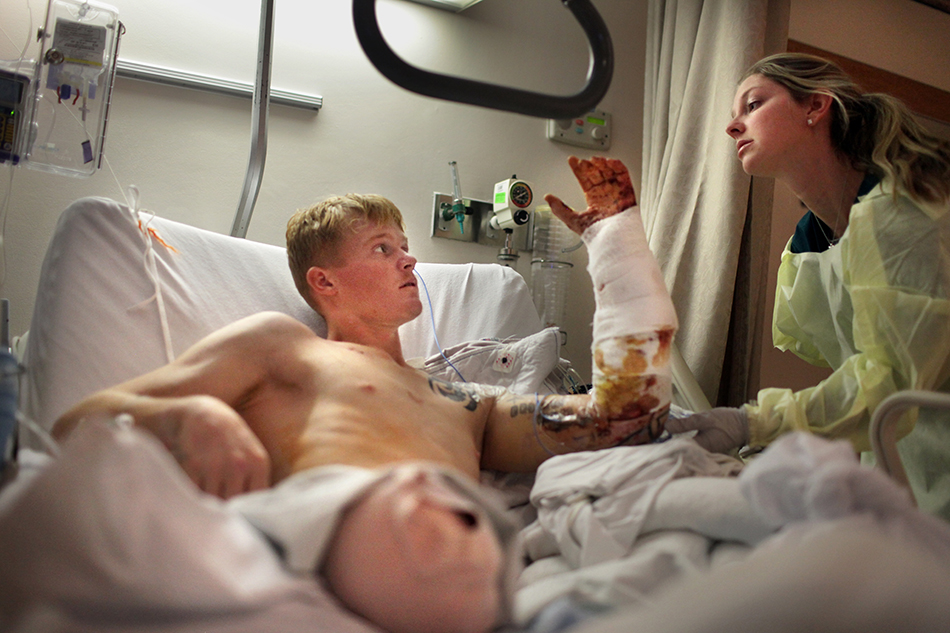
I was a little nervous entering his hospital room. I hoped Justin and his family would be open to me, but I was also completely prepared for him to change his mind and turn us away. It would have been understandable. But he didn't. In fact, he was incredibly open with us. He said things like, "I lost my legs. Time to move on." I was certain he was in a state of shock and surely in days, weeks, or months, reality would set in. Well, I was wrong — that was just Justin. The doctors told him he'd be up on his prosthetics in a year. Four months later, I photographed him standing and walking on his new legs as he greeted his unit upon their arrival back in the states. That was the first goal he set — to show his brothers that he was OK. Before the plane landed he told me he was so nervous he felt his legs shaking. He worried his brothers would hug him so hard he’d fall out of his prosthetics. I watched stubbornness, anger and determination propel him to his feet as they walked off the plane. Later that night, as the guys told war stories and drank beer, the television at Joe’s Crab Shack showed President Obama announcing the death of Osama bin Laden. The men could've cared less. They told me, “Ok, then bring them home. We’re losing valuable Marines every day.”
This was the night that symbolized the completion of their mission, and they acknowledged it with little more than a nod. Many joined because their dads and brothers were Marines. They joined to become men. They joined to be somebody. And their lives will be played out far from the halls of power where their destiny was determined. I feel it's crucial that we continue to tell the stories of our military men and women. We must not forget the many lifelong battles that are just beginning as the wars 'wind down'.
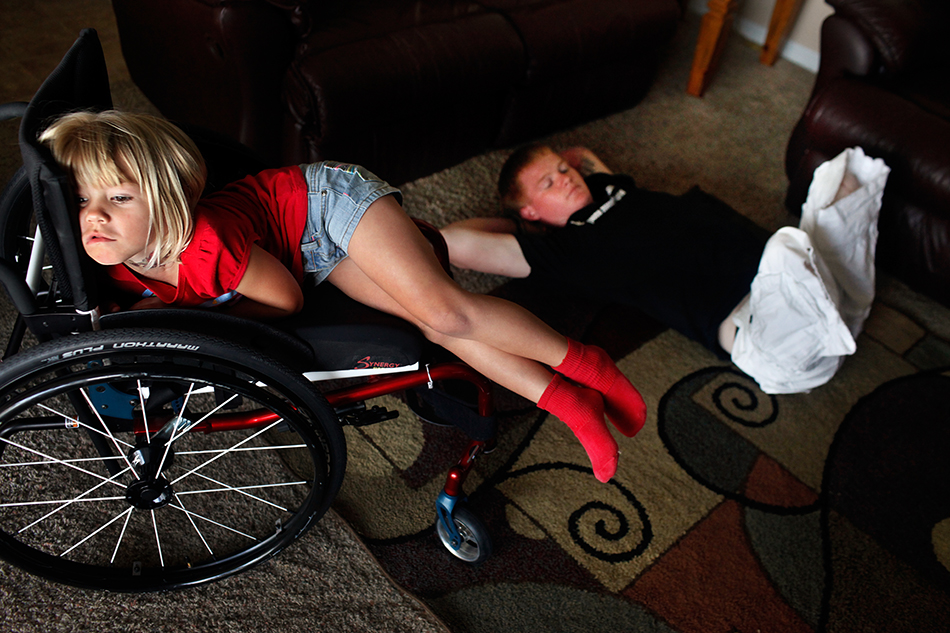
When I was in Afghanistan that fall, Joao Silva had been hurt while working in Kandahar for The New York Times. I had been to Kandahar just days before. Joao's injury hit home with me and obviously the photojournalism community and world at large. When I was invited to be a part of a fundraiser for him several months after my return, it was a no brainer that I would contribute in whatever way possible. Jackie Spinner, a reporter who had previously been Baghdad Bureau Chief for the Washington Post had the idea for Conflict Zone, an exhibition of war related photography with the intent of raising money for Joao. She teamed up with Steve Luker, who ran a non-profit called the Independence Fund, which supported wounded military.
Once I became involved with Conflict Zone, Steve saw the original story we did on Justin and he reached out to me, wanting to help Justin in whatever way he could. Thus a relationship between the Independence Fund and Justin began.
Fast-forward 10 months, the Independence Fund brought both Justin and I to South Carolina during a retreat for wounded military. I was there along with photographer Nicole Fruge in a volunteer capacity and Justin came down with the NYFD to deliver the piece of the trade towers to the Marine Corps Recruit Depot.
While I had been following Justin for about a year at that point, I went into the weekend with the idea that I would not document him for my story, because I felt like I was there in another capacity and somehow it seemed like I had played too much of a role in him being there, simply by the fact that Luker wouldn't have known about Justin had I not done the initial story. It just felt like murky waters to me.
So, even as I was making photos of Justin's return to Parris Island for the first time since he had been in boot camp, I thought the photos would be for the Independence Fund, not for my own story. But just after I made this photo, Nicole approached me and said something about how that moment was going to be important to my story on Justin. I've long admired Nicole, as a photographer and as a person. I let the thought sink in and I realized she was right. It would have been silly to exclude this incredibly powerful moment in his story. It was real. The moment was the result of a domino effect of connections, which could be traced back to my trip to Afghanistan, my original story on Justin, Joao being injured, to Luker and Jackie starting the fundraiser for Joao, or to any other number of events. But Justin being there that day was not orchestrated by me. It was a real and powerful moment.
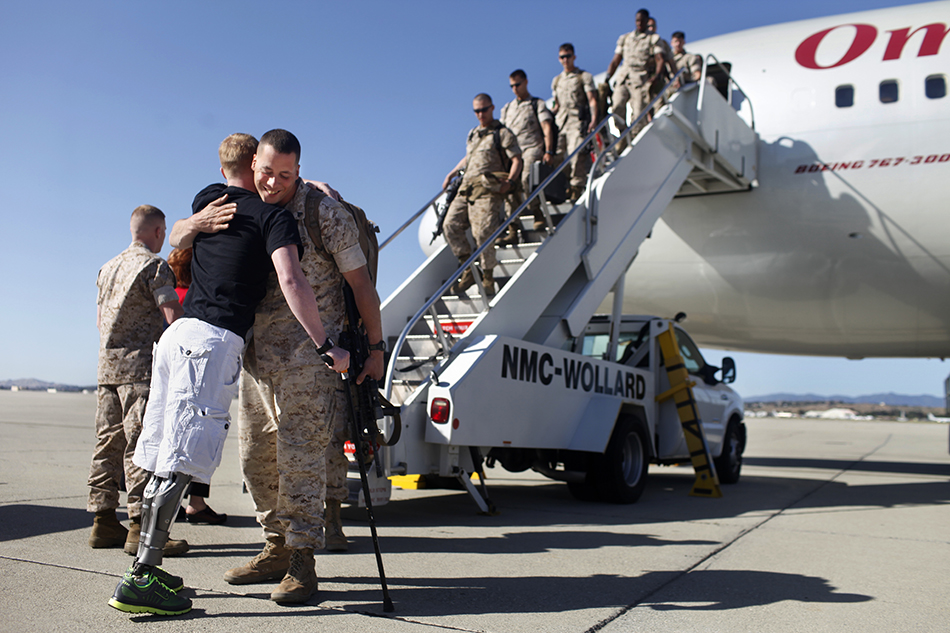
TID:
What challenges did you encounter while working on this story?
KATHLEEN:
Distance was an issue with this story. Much of the time I worked on it, Justin was still at Walter Reed in DC, and I was in Florida. Luckily, I worked for some amazing editors — Bruce Moyer and Boyzell Hosey — who believed in me and sent me on several crucial trips. At a time when budgets are tight, a flight to California from Florida is a lot to ask at a newspaper. But they made it happen. Obviously this story wouldn't have occurred without that kind of support.
But I also visited Justin on my own time, when I happened to be in DC for personal reasons. If you are really doing this photojournalism thing, you've probably realized what we do is more than a job. You invest so much in these types of projects that they take over your life and readers rarely get to see the subplots that develop over time.
For instance, Bruce Moyer, my editor on the story, did a fantastic job with editing this project. He secured massive real estate in our paper and worked with his amazingly talented page designer wife, Suzette Moyer, on the layout. It looked great. I’ve worked with Bruce on many stories but it’s my experiences with him on this project that I always think about first when I remember how much he’s impacted me as a photographer and my work at large. His editing on this story won him a second place in BOP (he placed first in that category for another story) and that same year he was photo editor of the year. We lost Bruce in December to cancer. It's a huge loss to photojournalism, but I'm certain we'll see his influence remain in the work we do, how we do it, and how we aspire to do it.

TID:
How did you handle and overcome the problems you encountered on this story?
KATHLEEN:
I think you have to be flexible. You never know where it’s going to take you, and if you work at a newspaper, you need an editor to back you up wherever the story leads. While the Times did a lot to make the story happen, I also put in my own time and effort. When I traveled to D.C. on my own, I took time out to see Justin. When I feel passionately about a story, I often go beyond work hours. There were also a lot of sleepless nights producing the video for this piece. If the story’s worth it, sometimes you’ll have to sacrifice for it — especially in these times of small staffs and budgets. I’m saying this knowing full well that if you are in the business you probably are already living this. All that said, don’t work for free!
TID:
What have you learned about yourself in the process of making images like this?
KATHLEEN:
I think working on this story reinforced in my mind the idea that human behavior isn’t always predictable. I think in the back of my head I had a map for what Justin’s journey would be like. I would never have guessed that under a year after meeting him in a hospital bed I’d be photographing him doing breakdancing moves at a party on his nubs. So I am always surprised, always learning and pretty much constantly finding myself humbled by my subjects. But that’s a big reason why I love my job.
TID:
What have you learned about others, as well as him through this experience?
KATHLEEN:
I learned that walking in prosthetic legs is not only hard, it is incredibly painful. I've learned some people out there actually treat amputees in horrifyingly disrespectful ways. I’ve been forever changed by the resolve and strength I’ve seen in Justin and the many other wounded military I met while working on his story.
TID:
Now, onto the moment. Can you talk about the moments leading up to the picture and also the actual moment.
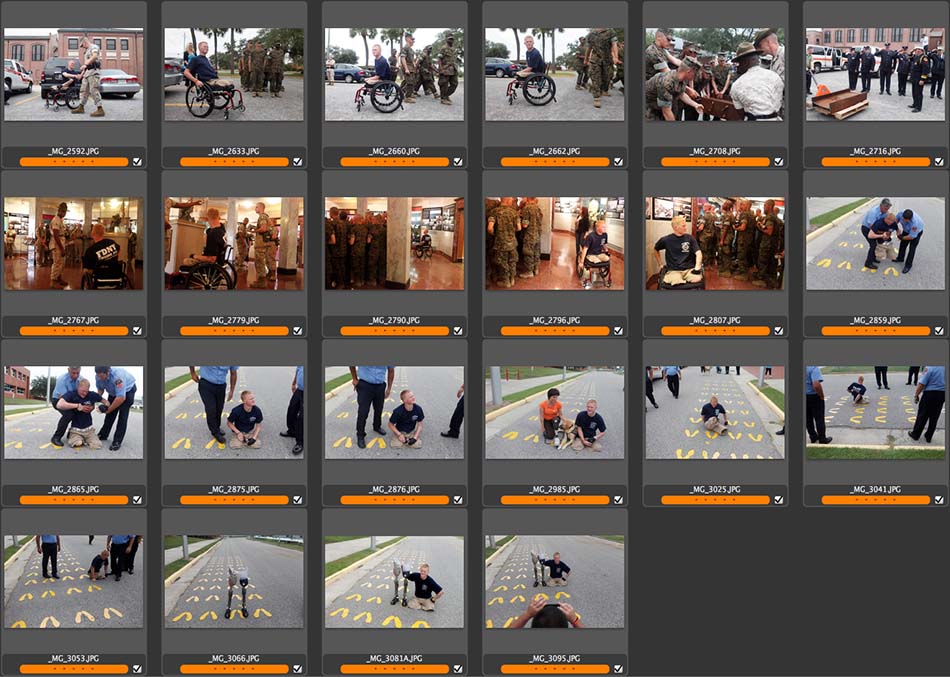
KATHLEEN:
As we rode onto the island I could tell Justin's mood was changing. His eyes were wide and leaned close to his window as he gazed across the campus. He wanted to see the recruits. He pointed out different landmarks. Later he told me he was having a lot of mixed emotions during the visit. He was excited to be there but he also had some bad memories of that place along with the magnitude of all that he had seen and endured in the last four years or so since his journey as a Marine began.
While in the Marine Corps museum, I watched as recruits looked at Justin nervously, greeting him with a, “Good afternoon, sir.” At one point Justin rolled himself in his wheelchair outside and to the end of the sidewalk. He sat there alone and silent, looking around. I watched from inside, where he couldn't see me. I didn't make a photo. I felt like he needed that moment alone.
As we were leaving, Justin said he wanted to see "the footprints.” I honestly had no idea what he was talking about. He explained its significance. One of the New York firefighters who drove down with Justin was Richie Canon. Richie's first day with the FDNY was supposed to be September 11, 2001. He was sick that day, didn't go into work and his entire firehouse died in the towers. Justin climbed onto Richie's back from the passenger seat of the van and Richie held onto Justin's nubs as he walked him over to the footprints. It was moments like this that reminded me of Justin's vulnerability. While I had seen him at his lowest point — in a hospital bed, his limbs freshly amputated — the more time I spent with Justin, the easier he made things seem. Since that time, he had blazed through every goal he set for himself. Unflinchingly. Like I said earlier, before I met Justin, I had some thoughts in my mind about what his journey might be like. They involved a lot of struggle. And while there was an incredibly high level of pain and difficulty that I will never quite understand, more than anything for that year that I spent with him, what I will remember the most is how much ass he kicked. I saw a fighter, determined to gain back his independence.
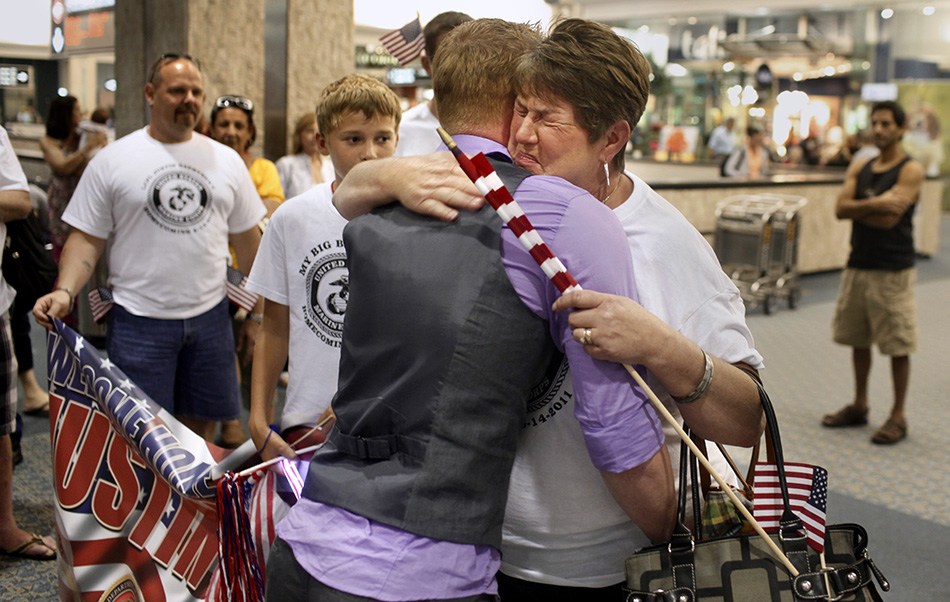
TID:
What surprised you about the moment?
KATHLEEN:
Well, as I mentioned before, the entire situation was a surprise. As it was happening I just had to snap into ‘the zone’ and focus on making photos.
TID:
In conclusion, what advice do you have for photographers?
KATHLEEN:
Over 14 years ago (ouch!), on my very last day as an intern at the Springfield State Journal Register in Illinois, photographer Chris Young had a long talk with me. Before that night, we had nary a conversation. He looked at some of my work and loved some images I had made of my grandmother. He left me with this message: Work on stories that you feel passionately about. Things you hold close to your heart. I know, that sounds like a no-brainer. But the truth is, if it is something you connect with on a deep level, you will naturally be an effective storyteller. In turn you will do justice to your subject, yourself and your profession. It seems to me that especially when starting out in this field, some folks attempt stories that might be sexy or eye candy to improve their portfolios. That's fine — and I think there is great value in pushing your boundaries and exploring topics you might not know a lot about. But sometimes the simple idea of telling stories that you truly feel close to is sometimes forgotten. The substance of your photos, the moments you find through connection is what makes you a good storyteller. Don't forget that.

:::BIO:::

Kathleen Flynn joined the staff of the New Orleans Times-Picayune/Nola.com in January 2013 after a decade at the Tampa Bay Times in Florida. In addition to her dedication to community journalism in Florida and Louisiana, she has covered the tsunami in Thailand, immigration in Mexico, post-conflict Liberia, India’s booming pharmaceutical industry, the war in Afghanistan, and Haiti. Her work has received numerous awards, including a 2013 regional Emmy and honors in 2012 and 2013 from the National Press Photographers Association’s Best of Photojournalism.
You can see her work here:
And work on Justin's story here: